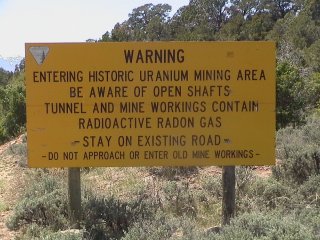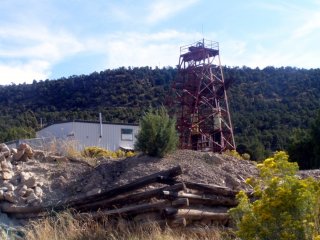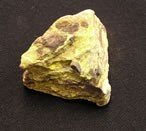Radioactive Waste From Uranium Mining and Milling
- Regardless of how uranium is removed from rock, the extraction process creates radioactive wastes. If not managed properly, mining waste and mill tailings can contaminate the environment.
Uranium is a naturally-occurring radioactive element that has been mined and used for its chemical properties for more than a thousand years. It is now primarily used as fuel for nuclear reactors that make electricity. Uranium can be recovered in two ways: by conventional mining of the rock (ore), or by using strong chemicals to dissolve uranium from the rock that is still in the ground and pumping it to the surface.
About Radioactive Waste From Uranium Mining and Milling
Industries in the United States recover uranium from the Earth through mining or chemical extraction.
- Mining: When uranium is near the surface, miners dig the rock out of open pits. Open pit mining strips away the topsoil and rock that lie above the uranium ore. When uranium is found deep underground, miners must dig underground mines to reach it. The rock is then removed through underground tunnels.
- In situ leaching: “In situ” is Latin for “in place.” In situ leaching ISL), or in situ recovery (ISR), is the process of pumping chemicals into groundwater to dissolve uranium in porous rocks (typically sandstones. When uranium is located in an area saturated by groundwater, at relatively greater depths and generally lower concentrations than for conventional mines, in situ leaching may be used. After the chemicals are put into the ground, the liquid containing uranium is pumped to the surface through a network of wells and then processed to recover the uranium. This has become the most commonly used uranium extraction method in the United States in recent decades, especially in Texas and Wyoming.
Once the uranium ore is extracted from the Earth, it must be processed to get the uranium from the ore. There are a few processes that can be used to recover uranium:
- Milling: This process takes place at a mill after the ore containing uranium is removed from the Earth through open pit or underground mining. The ore is brought to a mill, crushed, and ground up before chemicals are added to dissolve the uranium. The uranium is then separated from the chemical solution, solidified, dried and packaged.
- Heap leaching: This process uses a liquid to dissolve metals found in rocks (ores). Similar to the way pouring hot water over crushed coffee beans leaves coffee grounds (waste) and liquid coffee, spraying chemicals over piles of uranium-containing crushed rock leaves the leftover rock and a liquid containing uranium. The liquid then needs further processing to recover the uranium. This processing method is not currently used in the United States for uranium, but it is used for gold.
Regardless of how uranium is extracted from rock, the processes leave behind radioactive waste. These processes separate uranium from its decay products which are also radioactive and actually contain most (80-90%) of the radioactivity in the rock (ore). The solid radioactive wastes that are left over from the milling processes are called tailings and the liquid wastes are called raffinates. Mill tailings and raffinates are stored in specially designed ponds called impoundments. The tailings remain radioactive and contain hazardous chemicals from the recovery process.

Uranium eventually decays to radium A naturally occurring radioactive (unstable) element that forms when uranium or thorium decay. Elevated levels of radium can contaminate water supplies. Radium also poses a risk when it decays to form radon, a radioactive gas.. Radium decays to release a radioactive gas called radon. Open pit uranium milling and in situ mining sites do not pose a significant radon risk to the public or to miners; the radon disperses into the atmosphere. In the past, the waste rock produced by underground and open pit mining was piled up outside the mine. This practice has caused problems, including on Navajo lands where more than half of the small, abandoned uranium mines from the middle of the 20th century and their wastes remain. Wind can blow radioactive dust from the wastes into populated areas and the wastes can contaminate surface water used for drinking. Some sites also have considerable groundwater contamination.
Underground mines can present a radiation hazard to miners. Without proper air ventilation, radon A naturally occurring (colorless and odorless) radioactive gas found in soils, rock and water throughout the United States. Radon causes lung cancer and is a threat to health because it tends to collect in homes, sometimes in very high concentrations. As a result, radon is the largest source of exposure to naturally occurring radiation. can collect in the mineshafts, where it is inhaled by miners. The operators of uranium mines must take special precautions to protect miners, such as pumping radon gas out of the mine and replacing it with fresh air. To protect the public near uranium mines, vented radon gas must not exceed certain limits. Sometimes miners are required to wear respirators that protect their lungs from radon gas. Learn more about the health effects of radon at Radon in Homes, Schools and Buildings.
Previously, waste rock and mill tailings were used in some Western mining areas as building materials for homes, schools, roads and other construction. Structures built with waste rock and mill tailings were radon and radiation hazards to anyone spending time in them. People traveling on roads made with waste rock were in danger of breathing radioactive dust. In response to these issues, the 1978 Uranium Mill Tailings Radiation Control Act (UMTRCA) stopped the use of mill tailings in building and construction projects.
What You Can Do
- Avoid both abandoned and operating mining sites and equipment. This will limit your exposure to potential radioactive wastes stored on-site.
- Obey safety instructions. Follow all posted warnings and safety guidance near operating or abandoned mining sites. You should never:
- Swim in or drink the water from open pit mine lakes.
- Drink the water from streams and springs near either abandoned or operating uranium mines.
- Remove rock or soil from a uranium mine.


